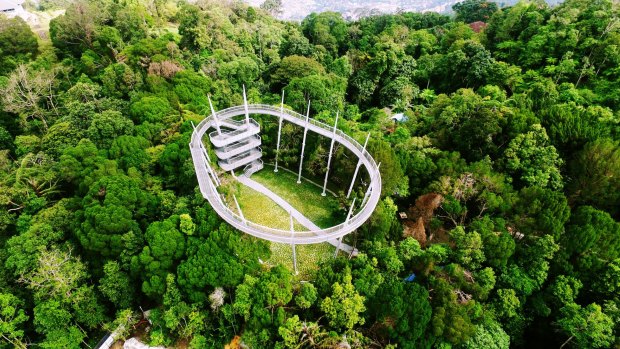This was published 6 years ago
The Habitat, Malaysia: Penang's new rainforest eco-experience
By Brian Johnston

The treetop canopy walk at The Habitat, Penang Hill.
I'm disgruntled to find it's raining in the rainforest. I want shafts of tropical light to come slanting through the giant trees to light up the shadowy under-canopy like a cathedral nave, spotlighting a suitably exotic tropical creature. Instead, rain glistens on spiders' webs, trickles down palm leaves and washes insect repellent into my eyes.
"Of course it rains in a rainforest," says Hermi, grinning like a leprechaun as water drips off the brim of his floppy hat. He's one of the rangers at The Habitat, and full of youthful enthusiasm. "Anyway no problem, we're following a paved path and the walk is only 30 minutes."
Most rainforest experiences aren't like this. Rainforests in my experience are usually in remote locations and involve hikes, mud, clouds of mosquitos and hideous discomfort. This newly opened eco-experience atop Penang Hill couldn't be easier, however, bar a few damp clothes. A seven-minute funicular ride has hoisted me 820 metres to the summit, from which views plunge downwards over the island-state's highways and high rises.
A quick walk around to the hill's west side and into The Habitat, however, brings an extraordinary contrast. There isn't a building in sight, just 130-million-year-old rainforest on green ridges that merge into the Andaman Sea.
Penang Hill's ridgeline is dotted with breeze-catching, colonial-era bungalows, and still marks the divide between urban and wilderness Penang. The Habitat's 1.6-kilometre Nature Trail hugs the contours just below these little bits of Britain but looks onto nothing but soaring, dripping jungle trees whose branches are festooned with creepers, orchids and bromeliads. A few well-placed swing benches along the track allow visitors to sit and contemplate the steaming forest and island views.
Good signage along the way provides interesting plant and animal information, but complimentary ranger tours are very worthwhile. There's nothing my guide Hermi – a trained naturalist – can't identify. We see mostly insects, many remarkable: green prehistoric monsters in miniature, carapaces glistening in the rain. Spiders hang in their universes of spun silk. Lizards wiggle across palm leaves. Giant pandans sit like huge green triffids in the jungle; their seven-metre leaves are the world's longest land-plant leaves.
We spot a pair of pretty Asian fairy-bluebirds and some dusky leaf langurs whose white-ringed eyes give them a permanently startled look. Rainforest creatures have names like mythical beasts from a science-fiction series. Giant black squirrel. Golden-knee tarantula. Greater racket-tailed drongo. Hermi recites their Latin names too, and scatters pleasing information. The drongos are smallish blue-black birds with elongated tail feathers and a knack for mimicry.
"They can imitate raptor calls that send other bird species into a panic. Then they move in and steal their food in the confusion," he says.
An encounter with nature always involves improbable tales. Another creature of this Malaysian rainforest is the slow loris. Its big primate eyes are seductively cute, but its bite can put you into anaphylactic shock. 'It releases a toxin from a gland at its elbow and mixes it with saliva,' explains Hermi. 'Not many animals have poisonous elbows!'
Sometimes I'm not sure whether Hermi is pulling my leg. He takes smirking pleasure in telling me about the world's biggest flower, which belongs to the giant deformed penis plant or Amorphophallus titan arum, which only flowers for a few days every few years. The banana-like yellow flower can grow over two metres high from its purple "grass skirt", and stinks like a corpse in order to attract carrion beetles.
Nature is so delightfully curious that The Habitat needs little else except its great ranger-guides to elucidate its marvels. Still, additional attractions are now under construction, including a museum, scenic treetop walk, 230-metre elevated canopy walk, and the world's longest rainforest zip line. Perhaps it risks morphing into a theme park.
For the moment The Habitat is an easy, family-friendly and fascinating encounter with a small corner of wild Malaysia. Yes, it might be raining, but of course it rains in a rainforest. It really doesn't matter. When you see a giant black squirrel leaping between trees, a few damp clothes seem like a reasonable sacrifice.
TRIP NOTES
MORE
FLY
Malaysia Airlines flies from Adelaide, Darwin, Melbourne, Perth and Sydney to Kuala Lumpur, with onward domestic connections to Penang. Phone 13 26 27, see malaysiaairlines.com
STAY
Cheong Fatt Tze Mansion is an impressive Chinese-style courtyard house. The east-west fusion cuisine of its Indigo restaurant is excellent. Rooms from $140. Phone +604 262 0006. See cheongfatttzemansion.com
TOUR
The Habitat Penang Hill is open daily except Wednesdays. Free guided tours every 30 minutes. Adult entry RM 20 ($6), children aged 3-13 RM 10 ($3). Phone +60 4 826 7677, see thehabitat.my
Brian Johnston travelled as a guest of Malaysia Airlines, Tourism Malaysia and Cheong Fatt Tze Mansion.
Sign up for the Traveller Deals newsletter
Get exclusive travel deals delivered straight to your inbox. Sign up now.